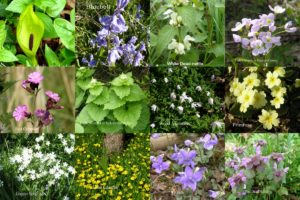If you are lucky enough to be near woodland or can walk along hedgerows, April is the perfect time to identify woodland flowers. Most flower early before they are shaded by the tree canopy above. The following is a list of 20 found in Patching Woods. See how many you can find, some may even be in your garden:-
Wood anemone (Anemone nemorosa) white/pink flowers
Primrose (Primula vulgaris) pale yellow flowers, large crinkly leaves
Bluebell (Endymion non-scriptus) blue, with cream anthers, long thin leaves
Dog’s Mercury (Mercurialis perennis) tiny, inconspicuous flowers
Violet (Viola species) blue/purple flowers, heart-shaped leaves
White Dead-nettle (Lamium album) white flowers, nettle-like leaves
Garlic Mustard (Alliaria petiolata) white flowers, other name Jack-by-the-Hedge
Ladies Smock (Cardamine pratensis) pale pink flowers, other name Cuckoo Flower
Greater Stitchwort (Stellaria holostea) white flowers, quite tall
Red Campion (Silene dioica) red flowers, tall
Lords-and-Ladies (Arum maculatum) purple or yellow spadix with green spathe (hood)
Wild Garlic (Allium ursinum) white flowers, strong-smelling, edible
Ground Ivy (Glechoma hederacea) violet/blue flowers, leaves kidney-shaped
Red Dead-nettle (Lamium purpureum) pink/purple flowers, square stems
Wood spurge (Euphorbia amygdaloides) tall, tiny flowers in yellow/green, cup-like bracts
Wood sorrel (Oxalis acetosella) white flowers, trefoil leaves, in ancient woods
Lesser Celandine (Ficaria verna) glossy yellow flowers, heart-shaped leaves
Goldilocks Buttercup (Ranunculus auricomus) small yellow variable petals, divided leaves
Early Purple Orchid (Orchis mascula) purple flowers in spike, black spots on leaves
Foxglove (Digitalis purpurea) very tall with purple flowers, large soft leaves
To help you identify the flowers, you can take photos on your phone or camera and then use the internet or an identification book to help you. I can recommend The Wild Flowers of Britain and Ireland by Blamey, Fitter and Fitter, second edition, 2013. Please do not pick the flowers. If you make your own list in a note book, record when and where you find the flowers and then you will build up a useful plant list.
do not pick the flowers. If you make your own list in a note book, record when and where you find the flowers and then you will build up a useful plant list.
A collage of 12 of these woodland flowers may help your identification.
